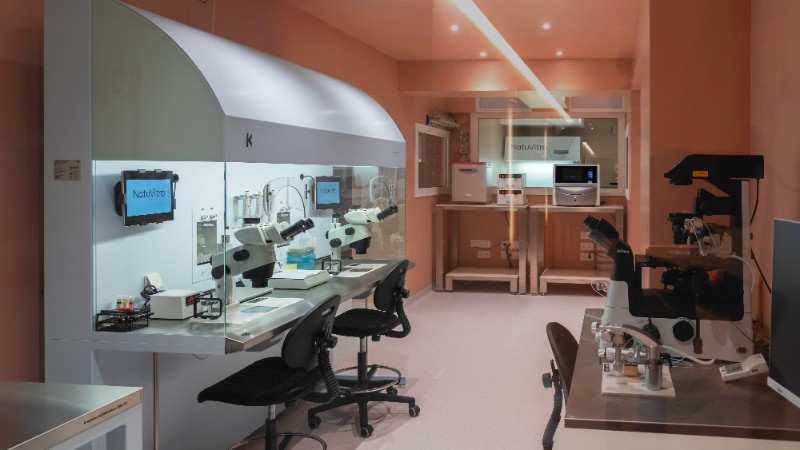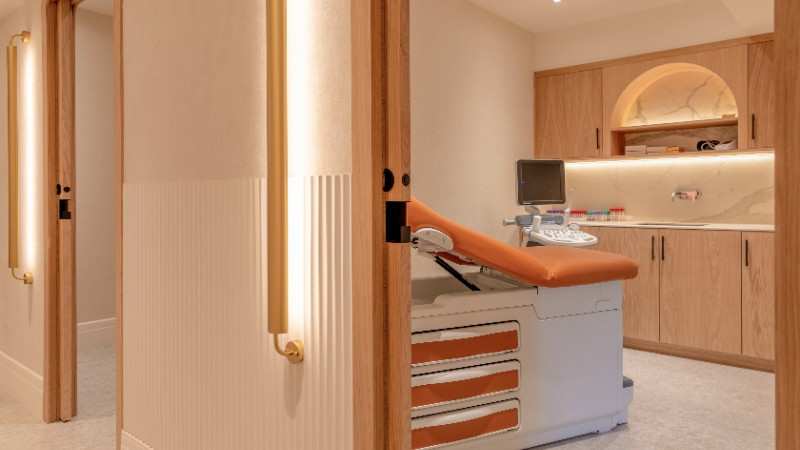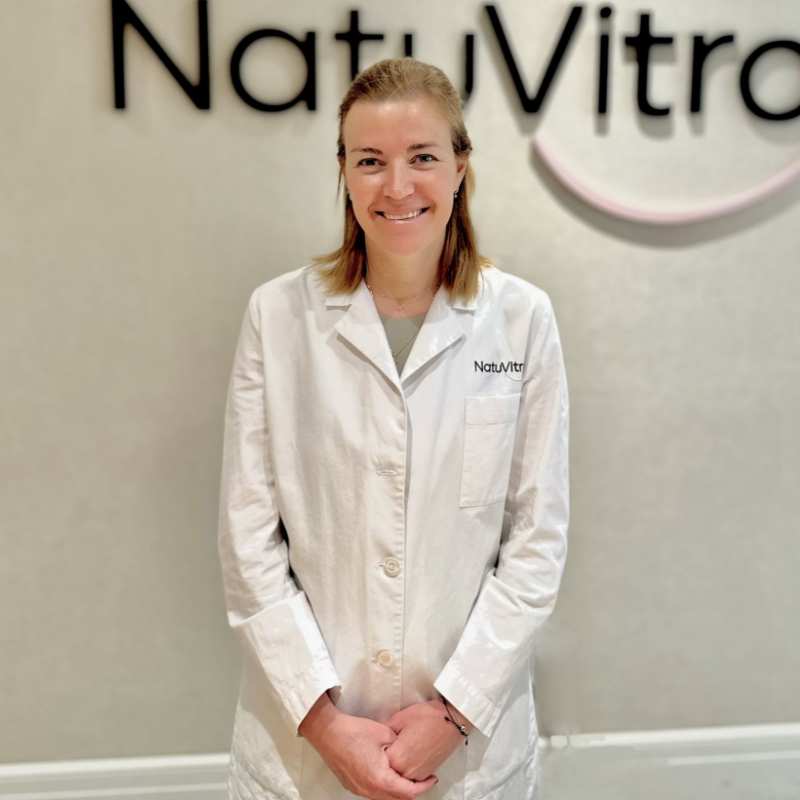
Infertility is not solely a woman's issue. In more than half of the cases, we see that the male factor causes or contributes to this situation. However, thanks to advances in Assisted Reproduction, we can offer the most suitable solution.
For a pregnancy to occur, the following conditions must be met:
- The man must produce healthy sperm.
- The woman must produce healthy eggs.
- The fallopian tubes must be open to allow sperm to reach the egg.
- The sperm must be able to fertilize the egg.
- The fertilized egg must implant in the uterus.
- The embryo must be healthy.
The woman's age and the duration of attempts to conceive can influence the treatment.
What are the causes of infertility?
There are many causes of infertility: female factors, male factors, or a combination of both:
Female factors
- Ovulation problems. The woman does not produce enough hormones to develop, mature, and release a healthy egg.
- Anatomical problems. An anatomical issue may prevent the egg and sperm from meeting. The most common problem is a blockage in the fallopian tubes. Other issues may relate to scar tissue in the pelvis due to previous surgeries or infections.
- Endometriosis. The tissue that lines the uterus implants outside the uterus. It often implants in other reproductive organs or in the uterus. Each month, this misplaced tissue reacts to the hormonal changes of the menstrual cycle. This means it accumulates, breaks down, and bleeds. This can cause scar tissue and affect fertility.
- Congenital malformations. Certain birth defects can affect fertility. One of the most common problems occurs when a female fetus is exposed to DES (diethylstilbestrol) in the mother's womb. In the 1940s and 1950s, pregnant women took this medication to prevent pregnancy loss. However, it was found to cause problems with the development of the uterus and cervix in the fetus, which in turn harmed the woman's ability to conceive.
- Infection. Pelvic inflammatory disease (PID) is caused by bacteria such as gonorrhea and chlamydia. PID can affect the uterus, fallopian tubes, ovaries, or all three. It causes scar tissue to form between the organs. This leads to chronic pelvic pain and increases the risk of ectopic pregnancy, where the fertilized egg implants outside the uterus.
- Immune system problems. A problem with a woman's immune system can lead to pregnancy loss. Antibodies in a woman's system may not recognize a pregnancy or may have an abnormal immune response to it. Women can also develop anti-sperm antibodies that attack and destroy sperm.
Male factors
- Low or absent sperm production. In the absence of a sufficient amount of healthy sperm, the chances of fertilization decrease.
- Abnormal sperm function. Sperm must be able to swim and penetrate the egg.
- Varicocele. This is a condition where varicose veins develop around the testicles. It is a very common cause of infertility in men and can usually be treated with surgery.
- Hormonal disorders. Abnormal functioning of male hormones or the endocrine system can affect sperm production and fertility.
- Chromosomal defects. Certain chromosomal abnormalities are associated with male infertility.
- Congenital malformations. Anomalies of the male reproductive system can occur during fetal development. Some congenital defects are due to male exposure to DES (diethylstilbestrol) taken by their mother during pregnancy.
- Immune system problems. A man may have anti-sperm antibodies, which attack and destroy sperm.
Lifestyle habits can also affect sperm quality and function: - Use of recreational drugs.
- Excessive alcohol consumption.
- Smoking.
- Taking certain medications.
- Exposing the genital area to excessive heat, such as using a hot tub.
When do we talk about infertility?
A couple is considered infertile if there is no conception:
- After one year of unprotected intercourse.
- After 6 months for women over 35 years old.
- If there are known problems causing infertility.
How do we diagnose infertility?
A specialist will perform tests on both the man and the woman, and in some cases, a reproductive endocrinologist may need to intervene. These tests aim to answer the following questions:
- Does the woman ovulate regularly?
- Does the man produce healthy sperm?
- Can the woman's egg and the man's sperm unite and develop normally?
- Is there any implantation issue?
- Can the mother maintain the pregnancy?
Tests that are usually part of the basic infertility evaluation.
The couple
Medical and sexual history to look for possible physical causes of infertility and to know if they are having intercourse at the right time.
Woman
- Complete physical examination including a Pap smear and infection screening.
- Evaluation of ovulation. Checking that ovulation occurs by recording basal temperature or through other methods using urine samples.
- Hormonal analysis. Hormonal tests may be recommended since certain hormones rise and fall at different times during the monthly cycle.
- Ultrasound. An ultrasound can show the follicles, which are the sacs containing developing eggs. It can also show the thickness of the uterine lining. The specialist can also look for problems such as ovarian cysts or fibroids.
- X-rays. A hysterosalpingography may be recommended. For this test, a dye is injected into the opening of the cervix to view the inside of the uterus. This allows the radiologist to see if the fallopian tubes are open.
The man
- Check sperm count.
- Check sperm motility.
- Check sperm morphology.
- Evaluate the ejaculate fluid.
Other tests may be performed to check the sperm's ability to penetrate the egg, as well as measuring male hormones.
In some cases, the urologist will need to perform additional tests.
How is infertility treated?
The specialist will evaluate:
- Your age.
- Your overall health and medical history.
- Your ability to tolerate specific medications, procedures, or therapies.
- The expected duration of the condition.
- Your opinions or preferences.
Once the diagnosis is made, it's time to agree on the appropriate treatment, which can vary greatly depending on the cause of infertility.
Types of treatments
Intrauterine insemination.
This method uses a small flexible tube called a catheter to place specially washed and prepared sperm directly into the uterus. It may be used in cases of low sperm count or cervical mucus problems. This method is often used with ovulation medications.
Ovulation medications.
These medications help regulate the timing of ovulation. They stimulate the growth and release of mature eggs. They can also help correct hormonal problems that may affect the uterine lining. Ovulation medications can stimulate the release of multiple eggs, increasing the chances of having twins or other multiple births. Here are some of the most common medications:
- Clomiphene Citrate.
- Human menopausal gonadotropins. Medications that contain follicle-stimulating hormone (FSH) and luteinizing hormone (LH).
- Follicle-stimulating hormone (FSH).
Surgery.
Surgery can be used to treat or repair a condition such as a blockage of the fallopian tubes or endometriosis. It can be performed laparoscopically. During a laparoscopy, a small instrument inserted into the abdominal or pelvic cavity allows the doctor to clearly see the internal organs and perform a minimally invasive procedure.
In Vitro Fertilization (IVF).
This involves taking a woman's eggs and fertilizing them in the laboratory with sperm. The embryo is then transferred to the woman's uterus through the cervix.
IVF is the most common form of assisted reproduction. It is often the treatment of choice for a woman whose fallopian tubes are blocked, severely damaged, or absent. IVF is also used in cases of infertility due to endometriosis or male infertility. IVF is sometimes used to treat couples with unexplained long-term infertility who have not achieved a pregnancy with other treatments.
ICSI
Intracytoplasmic sperm injection (ICSI) is a procedure where a single sperm is injected directly into an egg. This method is most commonly used to resolve male infertility issues.
Gamete Intrafallopian Transfer (GIFT).
This method involves using a fiber-optic instrument called a laparoscope to guide the transfer of eggs and unfertilized sperm into the woman's fallopian tubes through small incisions in the abdomen. GIFT is only used in women with healthy fallopian tubes. Zygote Intrafallopian Transfer (ZIFT). This technique involves fertilizing a woman's eggs in the laboratory. Then the laparoscope guides the transfer of fertilized eggs (zygotes) into the fallopian tubes. ZIFT is only used in women with healthy fallopian tubes.
IVF with donor eggs
Assisted reproduction techniques that use donor eggs are more common among older women. The chances of a fertilized egg implanting are related to the age of the woman who produced the egg. Egg donors are typically between 20 and 30 years old.
Embryo cryopreservation.
In this method, embryos are frozen for transfer at a later date. This method is often used when an IVF cycle produces more embryos than can be transferred at the same time. The remaining embryos can be transferred in a later cycle if necessary.
Medical treatment for men.
Some men may have a hormonal problem that can be treated with the appropriate therapy. Hormonal imbalances caused by issues in the hypothalamus, pituitary gland, and testicles directly affect sperm development. Medication therapy may include treatment with gonadotropins, antibiotics, or other medications.
Surgery for men.
Surgery for male infertility aims to repair anatomical problems that interfere with sperm production and maturation or ejaculation. Removal of varicose veins (varicocele) can sometimes improve sperm quality.
In conclusion
We talk about infertility when the desired conception does not occur after a year of unprotected intercourse, after 6 months in women over 35, or if known problems causing infertility exist.
Infertility is not solely a women's issue. In more than half of the cases, there is a male factor as a direct or indirect cause. Depending on the cause, there are treatment options.
If you think you may need treatment, at NatuVitro we can help you.
Our experts are ready to examine your case history, clarify your choices, and address every question you have.
Don't wait to make informed decisions – your personalized guidance awaits!
- Spain (España)+34
- France (La France)+33
- Italy (Italia)+39
- United Kingdom+44
- United States+1
- Belgium (België)+32
- Switzerland (Schweiz/Suisse)+41
- Germany (Deutschland)+49
- Netherlands (Nederland)+31
- Afghanistan (افغانستان)+93
- Albania (Shqipëri)+355
- Algeria (الجزائر)+213
- American Samoa+1
- Andorra+376
- Angola+244
- Anguilla+1
- Antigua and Barbuda+1
- Argentina+54
- Armenia (Հայաստան)+374
- Aruba+297
- Ascension Island+247
- Australia+61
- Austria (Österreich)+43
- Azerbaijan (Azərbaycan)+994
- Bahamas+1
- Bahrain (البحرين)+973
- Bangladesh (বাংলাদেশ)+880
- Barbados+1
- Belarus (Беларусь)+375
- Belize+501
- Benin (Bénin)+229
- Bermuda+1
- Bhutan (འབྲུག)+975
- Bolivia+591
- Bosnia and Herzegovina (Босна и Херцеговина)+387
- Botswana+267
- Brazil (Brasil)+55
- British Indian Ocean Territory+246
- British Virgin Islands+1
- Brunei+673
- Bulgaria (България)+359
- Burkina Faso+226
- Burundi (Uburundi)+257
- Cambodia (កម្ពុជា)+855
- Cameroon (Cameroun)+237
- Canada+1
- Cape Verde (Kabu Verdi)+238
- Caribbean Netherlands+599
- Cayman Islands+1
- Central African Republic (République centrafricaine)+236
- Chad (Tchad)+235
- Chile+56
- China (中国)+86
- Christmas Island+61
- Cocos (Keeling) Islands+61
- Colombia+57
- Comoros (جزر القمر)+269
- Congo (DRC) (Jamhuri ya Kidemokrasia ya Kongo)+243
- Congo (Republic) (Congo-Brazzaville)+242
- Cook Islands+682
- Costa Rica+506
- Côte d’Ivoire+225
- Croatia (Hrvatska)+385
- Cuba+53
- Curaçao+599
- Cyprus (Κύπρος)+357
- Czech Republic (Česká republika)+420
- Denmark (Danmark)+45
- Djibouti+253
- Dominica+1
- Dominican Republic (República Dominicana)+1
- Ecuador+593
- Egypt (مصر)+20
- El Salvador+503
- Equatorial Guinea (Guinea Ecuatorial)+240
- Eritrea+291
- Estonia (Eesti)+372
- Eswatini+268
- Ethiopia+251
- Falkland Islands (Islas Malvinas)+500
- Faroe Islands (Føroyar)+298
- Fiji+679
- Finland (Suomi)+358
- French Guiana (Guyane française)+594
- French Polynesia (Polynésie française)+689
- Gabon+241
- Gambia+220
- Georgia (საქართველო)+995
- Ghana (Gaana)+233
- Gibraltar+350
- Greece (Ελλάδα)+30
- Greenland (Kalaallit Nunaat)+299
- Grenada+1
- Guadeloupe+590
- Guam+1
- Guatemala+502
- Guernsey+44
- Guinea (Guinée)+224
- Guinea-Bissau (Guiné Bissau)+245
- Guyana+592
- Haiti+509
- Honduras+504
- Hong Kong (香港)+852
- Hungary (Magyarország)+36
- Iceland (Ísland)+354
- India (भारत)+91
- Indonesia+62
- Iran (ایران)+98
- Iraq (العراق)+964
- Ireland+353
- Isle of Man+44
- Israel (ישראל)+972
- Italy (Italia)+39
- Jamaica+1
- Japan (日本)+81
- Jersey+44
- Jordan (الأردن)+962
- Kazakhstan (Казахстан)+7
- Kenya+254
- Kiribati+686
- Kosovo+383
- Kuwait (الكويت)+965
- Kyrgyzstan (Кыргызстан)+996
- Laos (ລາວ)+856
- Latvia (Latvija)+371
- Lebanon (لبنان)+961
- Lesotho+266
- Liberia+231
- Libya (ليبيا)+218
- Liechtenstein+423
- Lithuania (Lietuva)+370
- Luxembourg+352
- Macau (澳門)+853
- North Macedonia (Македонија)+389
- Madagascar (Madagasikara)+261
- Malawi+265
- Malaysia+60
- Maldives+960
- Mali+223
- Malta+356
- Marshall Islands+692
- Martinique+596
- Mauritania (موريتانيا)+222
- Mauritius (Moris)+230
- Mayotte+262
- Mexico (México)+52
- Micronesia+691
- Moldova (Republica Moldova)+373
- Monaco+377
- Mongolia (Монгол)+976
- Montenegro (Crna Gora)+382
- Montserrat+1
- Morocco (المغرب)+212
- Mozambique (Moçambique)+258
- Myanmar (Burma) (မြန်မာ)+95
- Namibia (Namibië)+264
- Nauru+674
- Nepal (नेपाल)+977
- New Caledonia (Nouvelle-Calédonie)+687
- New Zealand+64
- Nicaragua+505
- Niger (Nijar)+227
- Nigeria+234
- Niue+683
- Norfolk Island+672
- North Korea (조선 민주주의 인민 공화국)+850
- Northern Mariana Islands+1
- Norway (Norge)+47
- Oman (عُمان)+968
- Pakistan (پاکستان)+92
- Palau+680
- Palestine (فلسطين)+970
- Panama (Panamá)+507
- Papua New Guinea+675
- Paraguay+595
- Peru (Perú)+51
- Philippines+63
- Poland (Polska)+48
- Portugal+351
- Puerto Rico+1
- Qatar (قطر)+974
- Réunion (La Réunion)+262
- Romania (România)+40
- Russia (Россия)+7
- Rwanda+250
- Saint Barthélemy+590
- Saint Helena+290
- Saint Kitts and Nevis+1
- Saint Lucia+1
- Saint Martin (Saint-Martin (partie française))+590
- Saint Pierre and Miquelon (Saint-Pierre-et-Miquelon)+508
- Saint Vincent and the Grenadines+1
- Samoa+685
- San Marino+378
- São Tomé and Príncipe (São Tomé e Príncipe)+239
- Saudi Arabia (المملكة العربية السعودية)+966
- Senegal (Sénégal)+221
- Serbia (Србија)+381
- Seychelles+248
- Sierra Leone+232
- Singapore+65
- Sint Maarten+1
- Slovakia (Slovensko)+421
- Slovenia (Slovenija)+386
- Solomon Islands+677
- Somalia (Soomaaliya)+252
- South Africa+27
- South Korea (대한민국)+82
- South Sudan (جنوب السودان)+211
- Spain (España)+34
- Sri Lanka (ශ්රී ලංකාව)+94
- Sudan (السودان)+249
- Suriname+597
- Svalbard and Jan Mayen+47
- Sweden (Sverige)+46
- Syria (سوريا)+963
- Taiwan (台灣)+886
- Tajikistan+992
- Tanzania+255
- Thailand (ไทย)+66
- Timor-Leste+670
- Togo+228
- Tokelau+690
- Tonga+676
- Trinidad and Tobago+1
- Tunisia (تونس)+216
- Turkey (Türkiye)+90
- Turkmenistan+993
- Turks and Caicos Islands+1
- Tuvalu+688
- U.S. Virgin Islands+1
- Uganda+256
- Ukraine (Україна)+380
- United Arab Emirates (الإمارات العربية المتحدة)+971
- Uruguay+598
- Uzbekistan (Oʻzbekiston)+998
- Vanuatu+678
- Vatican City (Città del Vaticano)+39
- Venezuela+58
- Vietnam (Việt Nam)+84
- Wallis and Futuna (Wallis-et-Futuna)+681
- Western Sahara (الصحراء الغربية)+212
- Yemen (اليمن)+967
- Zambia+260
- Zimbabwe+263
- Åland Islands+358
Visit our clinic
Location
Call us now
Leave a message







